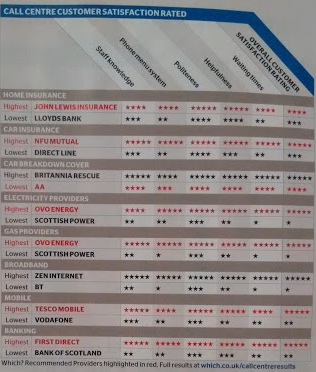The June 2015 edition of the venerable Which? magazine has a feature assessing call centre satisfaction ratings. For those not familiar with it, Which? magazine is something of an anomaly in the modern, sharing, online world. It is a subscription only magazine and online site. It takes no advertising allowing it to be completely unbiased in its assessments. It is also extremely popular with 680,000 paying subscribers to the magazine and 350,000 online subscribers In the UK, its opinion matters.
Call Centre Satisfaction Survey 2015

The summarised results are above – apologies for the quality of the image but it is not available online. The full results are available by industry and can be found here although it is possible depending on when you read this that Which? will obscure the results for non-subscribers.
Now let’s be clear on what it is that Which? is assessing; it is looking at call centres and their providers and there is a large degree of dissatisfaction especially in the broadband and energy sectors. It is assessing them (based on customer feedback) on staff knowledge, phone menu, politeness, helpfulness and waiting times. This generates and ‘Overall Customer Satisfaction Rating’.
Are Which? assessing the right criteria?
We can’t comment on the validity of the findings, nor do we dispute their accuracy. But is the assessment of the call centre really the right way to assess the customer service a company provides?
Forrester, earlier this year, reported that at least half of us prefer to get our support information online rather than making a call. Indeed if someone is forced to make a call to a call centre it is often because of a failure of the company to provide the right information on the website. And while it is true the the Which? subscriber base skews a little older than the general population is it really right to assume that they want to go a call centre as the first port of call.
Customer satisfaction goes way beyond the call centre
To assess the customer satisfaction correctly, in our opinion, then there needs to be an assessment of the entire customer journey starting with the online experience. This is especially true if you are going to rank companies for their customer satisfaction. For instance on ‘Waiting times’ nobody achieves the 95% of calls answered within 5 minutes that the Which? readers say they want. Now this could be because of under-resourcing. But equally it could be that the valuable time of the call centre staff is being spent on routine queries that could be much more easily resolved on the website.
Talk Talk say for instance (in response to Which?)
‘We’ve launched an extensive programme to enhance agents’ training. simplify our systems…,and make it easier for customers to manage their accounts online.’
BT says
‘We are investing significantly in our systems…Our online help and live chat gives customers instant access to experts.'
So the providers themselves clearly recognise that the experience is not confined to the call centre. A far more useful survey would be, we think, to try and resolve some common issues and perhaps even some less common, and see at what point the customer has to resort to the the call centre.
Considering other customer channels in addition to the call centre
We see our interactive guides as part of a much broader set of user friendly tools that includes live chat, FAQ’s, searchable knowledge bases, online help and simple account management and creation. Being able to efficiently guide customers around the core journeys and find what they need online reduces the load on the call centre and helps the human element to focus more of their time on more complex queries. This is where the real impact on customer satisfaction can happen – straightforward queries resolved online and more complex interaction happening person to person.
This is not to discount the Which? finding of course. It is not acceptable that in many companies the knowledge of the staff is poor especially if by adopting our approach the queries that are patched through the call centres are more complex. However when industry experts are writing papers with title like ‘Contact Centers Must Go Digital Or Die’ it seems not just a bit unfair but also incomplete to only look at one aspect of that experience and present it as the whole piece. Especially when call centres are becoming just one aspect of an increasingly broad-ranging approach to delivering customer satisfaction.